
Engine manufacturer Cummins (NYSE: CMI) reported revenue ahead of Wall Street’s expectations in Q4 CY2024, but sales fell by 1.1% year on year to $8.45 billion. Its GAAP profit of $3.02 per share was 34.9% below analysts’ consensus estimates.
Is now the time to buy Cummins? Find out by accessing our full research report, it’s free.
Cummins (CMI) Q4 CY2024 Highlights:
- Revenue: $8.45 billion vs analyst estimates of $8.07 billion (1.1% year-on-year decline, 4.7% beat)
- EPS (GAAP): $3.02 vs analyst expectations of $4.64 (34.9% miss due to reorganization charges for Accelera segment)
- Adjusted EBITDA: $1.02 billion vs analyst estimates of $1.25 billion (12.1% margin, 18.3% miss due to reorganization charges for Accelera segment)
- Full year 2025 revenues expected to range from down 2% to up 3% (below expectations)
- Full year 2025 EBITDA expected to range between 16.2% and 17.2% of sales (above expectations)
- Operating Margin: 8.7%, up from -14.2% in the same quarter last year
- Free Cash Flow Margin: 10.4%, similar to the same quarter last year
- Market Capitalization: $47.77 billion
“Cummins delivered strong operational results in the fourth quarter and achieved record full year revenues, net income, EBITDA and EPS, despite a decline in heavy duty truck demand in North America,” said Jennifer Rumsey, Chair and CEO of Cummins.
Company Overview
With more than half of the heavy-duty truck market using its engines at one point, Cummins (NYSE: CMI) offers engines and power systems.
Heavy Transportation Equipment
Heavy transportation equipment companies are investing in automated vehicles that increase efficiencies and connected machinery that collects actionable data. Some are also developing electric vehicles and mobility solutions to address customers’ concerns about carbon emissions, creating new sales opportunities. Additionally, they are increasingly offering automated equipment that increases efficiencies and connected machinery that collects actionable data. On the other hand, heavy transportation equipment companies are at the whim of economic cycles. Interest rates, for example, can greatly impact the construction and transport volumes that drive demand for these companies’ offerings.
Sales Growth
Examining a company’s long-term performance can provide clues about its quality. Any business can put up a good quarter or two, but the best consistently grow over the long haul. Thankfully, Cummins’s 7.7% annualized revenue growth over the last five years was decent. Its growth was slightly above the average industrials company and shows its offerings resonate with customers.
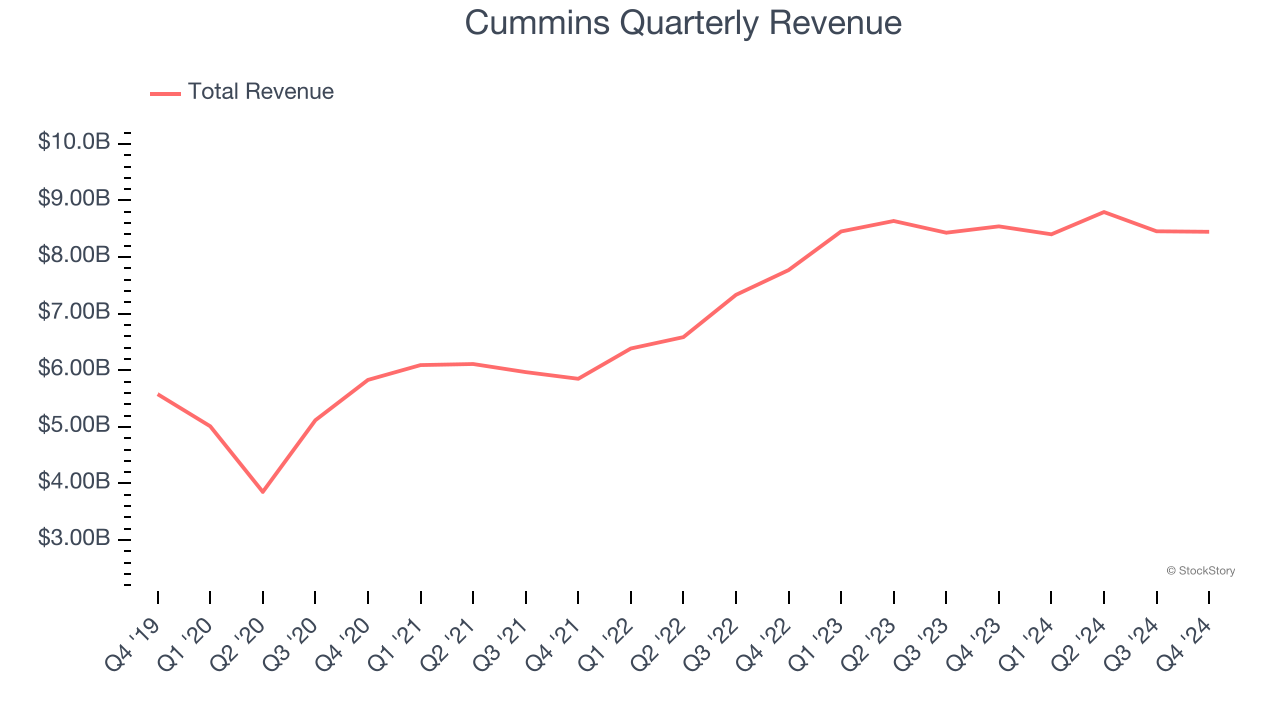
We at StockStory place the most emphasis on long-term growth, but within industrials, a half-decade historical view may miss cycles, industry trends, or a company capitalizing on catalysts such as a new contract win or a successful product line. Cummins’s annualized revenue growth of 10.2% over the last two years is above its five-year trend, suggesting its demand recently accelerated. 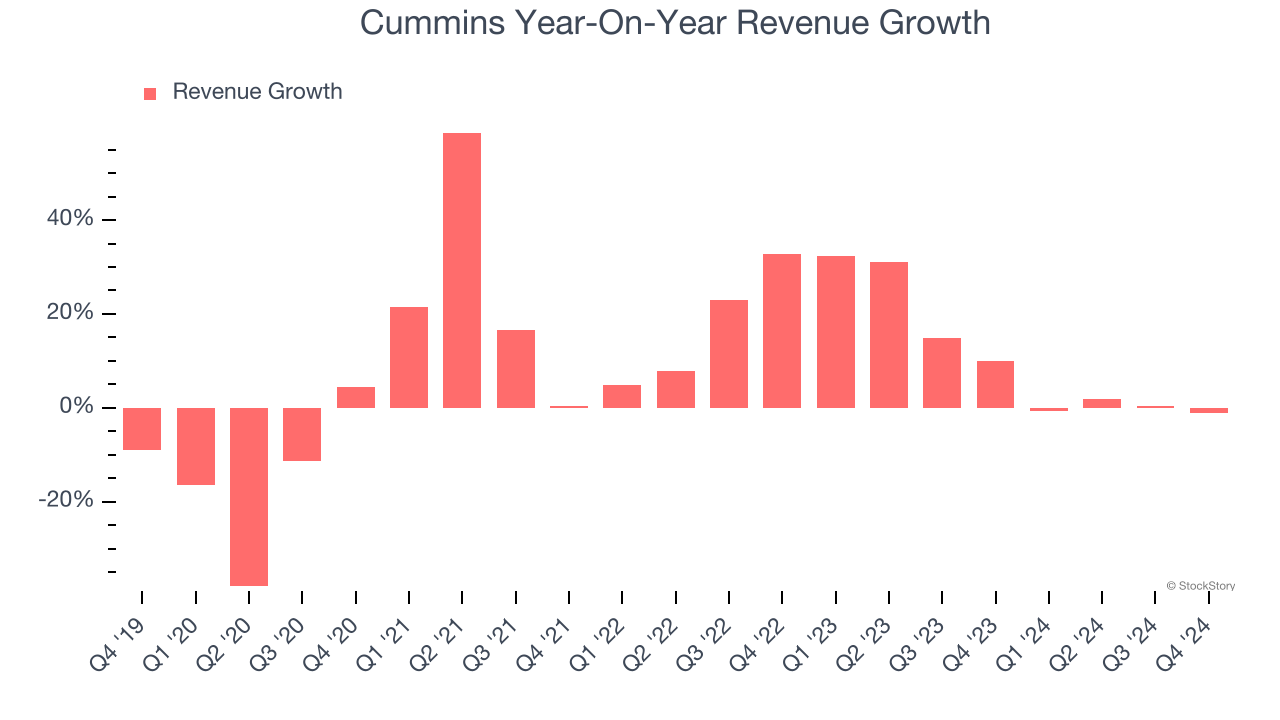
Cummins also breaks out the revenue for its most important segments, Components and Engine , which are 30.8% and 32% of revenue. Over the last two years, Cummins’s Components revenue (axles, brakes, drivelines) averaged 15.5% year-on-year growth while its Engine revenue (diesel and gas-powered engines) averaged 3.4% growth.
This quarter, Cummins’s revenue fell by 1.1% year on year to $8.45 billion but beat Wall Street’s estimates by 4.7%.
Looking ahead, sell-side analysts expect revenue to grow 1.6% over the next 12 months, a deceleration versus the last two years. This projection doesn't excite us and implies its products and services will see some demand headwinds.
Software is eating the world and there is virtually no industry left that has been untouched by it. That drives increasing demand for tools helping software developers do their jobs, whether it be monitoring critical cloud infrastructure, integrating audio and video functionality, or ensuring smooth content streaming. Click here to access a free report on our 3 favorite stocks to play this generational megatrend.
Operating Margin
Cummins has done a decent job managing its cost base over the last five years. The company has produced an average operating margin of 9.6%, higher than the broader industrials sector.
Looking at the trend in its profitability, Cummins’s operating margin might have seen some fluctuations but has generally stayed the same over the last five years . Shareholders will want to see Cummins grow its margin in the future.
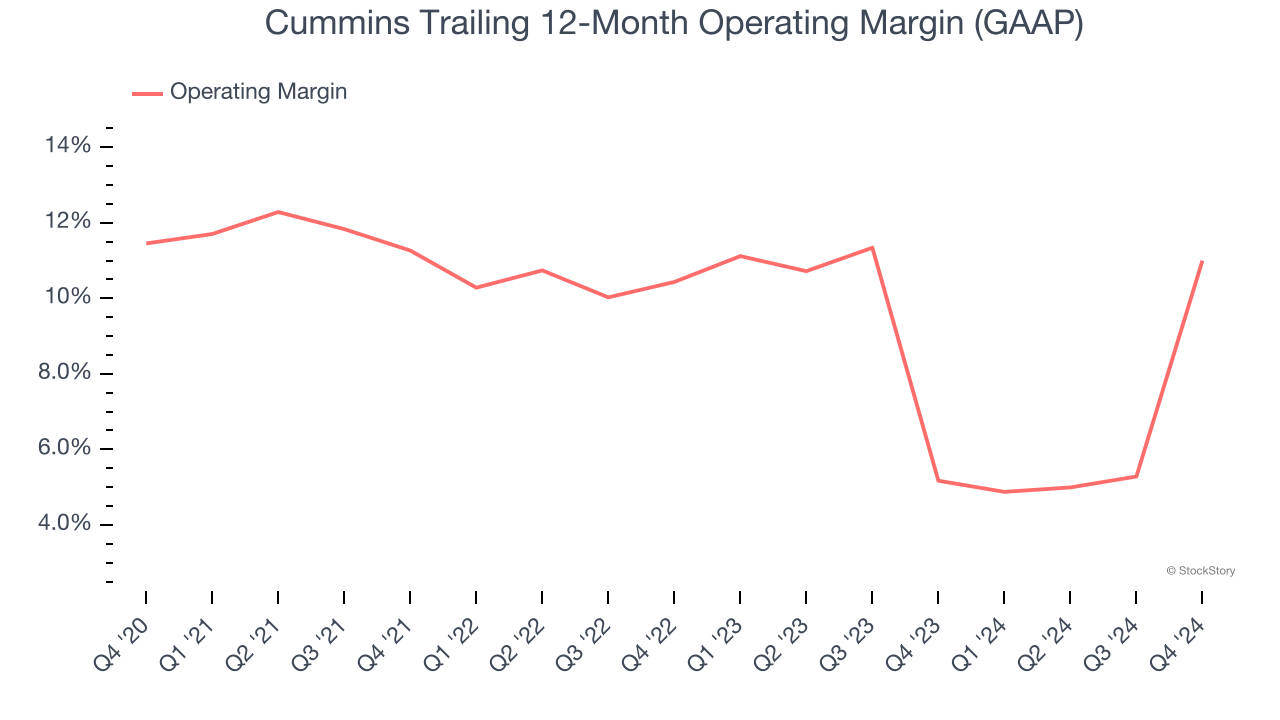
This quarter, Cummins generated an operating profit margin of 8.7%, up 22.9 percentage points year on year. The increase was solid, and since its operating margin rose more than its gross margin, we can infer it was recently more efficient with expenses such as marketing, R&D, and administrative overhead.
Earnings Per Share
Revenue trends explain a company’s historical growth, but the long-term change in earnings per share (EPS) points to the profitability of that growth – for example, a company could inflate its sales through excessive spending on advertising and promotions.
Cummins’s EPS grew at a remarkable 14.3% compounded annual growth rate over the last five years, higher than its 7.7% annualized revenue growth. However, this alone doesn’t tell us much about its business quality because its operating margin didn’t expand.
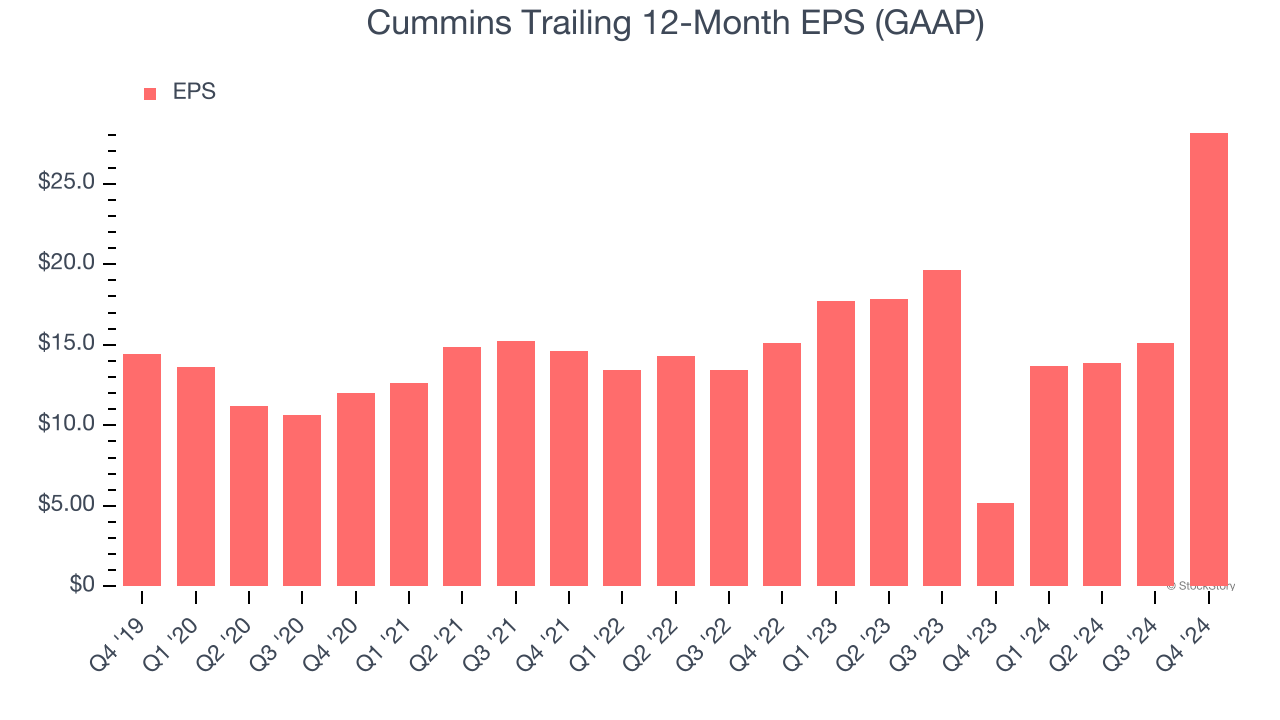
Diving into Cummins’s quality of earnings can give us a better understanding of its performance. A five-year view shows that Cummins has repurchased its stock, shrinking its share count by 9.2%. This tells us its EPS outperformed its revenue not because of increased operational efficiency but financial engineering, as buybacks boost per share earnings. 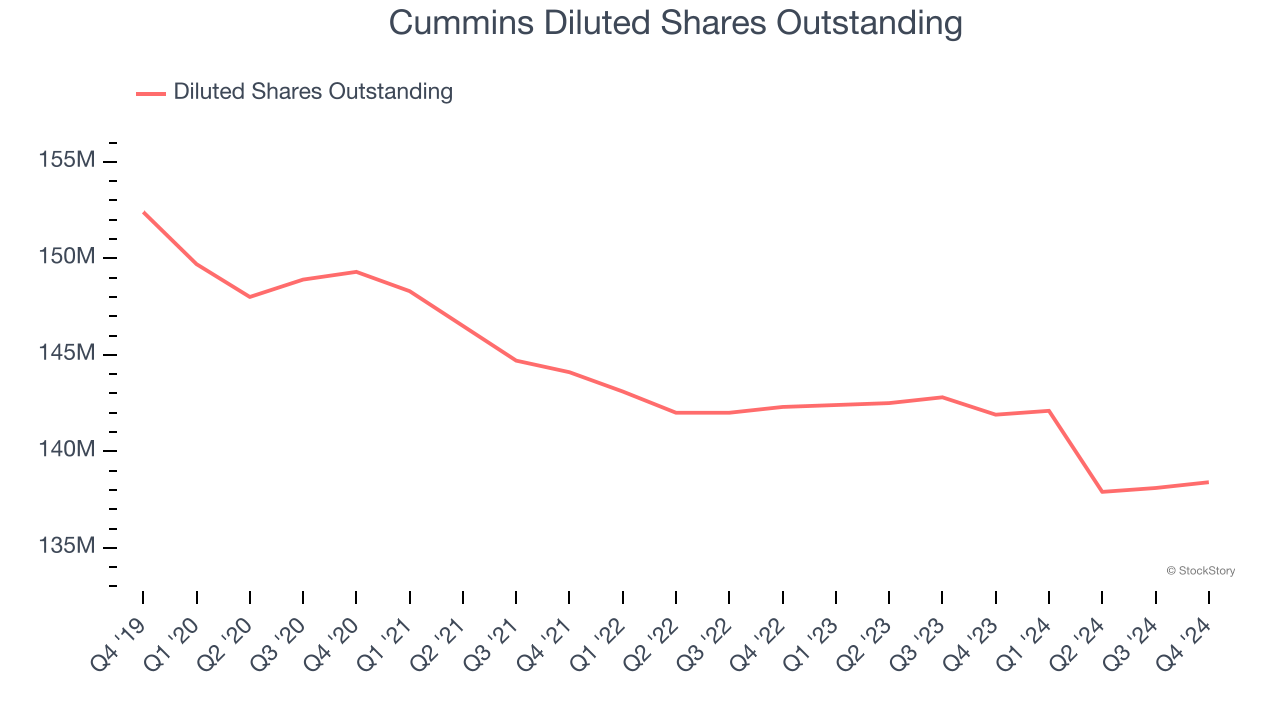
Like with revenue, we analyze EPS over a shorter period to see if we are missing a change in the business.
For Cummins, its two-year annual EPS growth of 36.5% was higher than its five-year trend. We love it when earnings growth accelerates, especially when it accelerates off an already high base.
In Q4, Cummins reported EPS at $3.02, up from negative $10.01 in the same quarter last year. Despite growing year on year, this print missed analysts’ estimates, but we care more about long-term EPS growth than short-term movements. Over the next 12 months, Wall Street expects Cummins’s full-year EPS of $28.17 to shrink by 20.2%.
Key Takeaways from Cummins’s Q4 Results
We were impressed by how significantly Cummins blew past analysts’ revenue expectations this quarter. Full-year guidance was mixed, with 2025 revenue guidance below expectations but 2025 EBITDA margin guidance above. Overall, this was a mixed quarter. The stock remained flat at $350 immediately following the results.
Big picture, is Cummins a buy here and now? What happened in the latest quarter matters, but not as much as longer-term business quality and valuation, when deciding whether to invest in this stock. We cover that in our actionable full research report which you can read here, it’s free.






